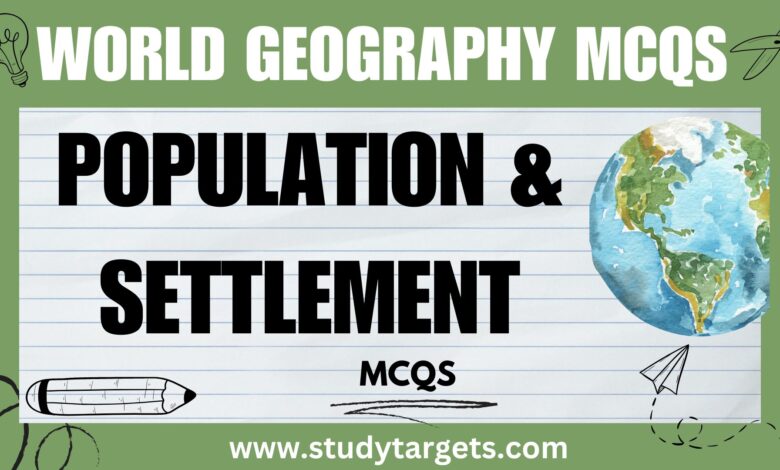MCQs: Population and Settlement : World Geography MCQs

Population and Settlement MCQs
1. Which term refers to the movement of people from rural to urban areas?
A) Immigration
B) Emigration
C) Urbanization
D) Suburbanization
Answer: C) Urbanization
2. Which factor is the primary driver of population growth in developing countries?
A) Increased immigration
B) Decreased birth rates
C) High fertility rates
D) High levels of urbanization
Answer: C) High fertility rates
3. A population pyramid with a wide base indicates:
A) High birth rates
B) Aging population
C) Stable population growth
D) Low birth rates
Answer: A) High birth rates
4. Which of the following countries is the most densely populated?
A) Russia
B) Canada
C) Bangladesh
D) Brazil
Answer: C) Bangladesh
5. The process by which people move from one country to another is called:
A) Urbanization
B) Migration
C) Settlement
D) Globalization
Answer: B) Migration
6. What is the main cause of rural-urban migration in developing countries?
A) Job opportunities
B) Poor weather
C) Lack of education
D) Population density
Answer: A) Job opportunities
7. What is a key characteristic of a “megacity”?
A) A city with a population over 10 million
B) A city with a high rural population
C) A city with a declining population
D) A city located near the ocean
Answer: A) A city with a population over 10 million
8. Which of the following regions has the highest urbanization rate?
A) Sub-Saharan Africa
B) North America
C) Latin America
D) Southeast Asia
Answer: C) Latin America
9. Which term refers to the planned development of housing, infrastructure, and services in an urban area?
A) Zoning
B) Urban planning
C) Demographic transition
D) Suburbanization
Answer: B) Urban planning
10. Which region of the world is experiencing the highest rates of population growth?
A) Europe
B) Sub-Saharan Africa
C) North America
D) Australia
Answer: B) Sub-Saharan Africa
11. The demographic transition model explains the:
A) Evolution of birth and death rates over time
B) Distribution of populations across continents
C) Causes of population decline in urban areas
D) Movement of people across borders
Answer: A) Evolution of birth and death rates over time
12. Which settlement pattern is characterized by homes and farms spread out over a large area?
A) Linear
B) Nucleated
C) Dispersed
D) Concentric
Answer: C) Dispersed
13. The term “fertility rate” refers to:
A) The number of births per 1,000 people
B) The average number of children born to a woman during her lifetime
C) The number of children per family
D) The birth rate in a rural area
Answer: B) The average number of children born to a woman during her lifetime
14. A city with a population exceeding 20 million is classified as a:
A) Large city
B) Megacity
C) Conurbation
D) Global city
Answer: B) Megacity
15. Which continent has the fastest-growing urban population?
A) Europe
B) Africa
C) Asia
D) South America
Answer: B) Africa
16. The term “infant mortality rate” refers to the number of:
A) Deaths of infants under one year old per 1,000 live births
B) Births per 1,000 people
C) Infant deaths in rural areas
D) Deaths during childbirth
Answer: A) Deaths of infants under one year old per 1,000 live births
17. A settlement where most of the population is involved in agriculture is called a:
A) Urban settlement
B) Rural settlement
C) Industrial settlement
D) Megacity
Answer: B) Rural settlement
18. Which of the following is an example of forced migration?
A) Job relocation
B) Refugees fleeing war
C) College students moving to a new city
D) People moving for better job opportunities
Answer: B) Refugees fleeing war
19. What is the most common reason for people moving to suburban areas?
A) Higher population density
B) Affordable housing and better living conditions
C) Proximity to large bodies of water
D) Access to industrial jobs
Answer: B) Affordable housing and better living conditions
20. The population density is defined as:
A) The total population of a country
B) The number of people living in an area per square kilometer
C) The birth rate of a city
D) The number of children born in a city
Answer: B) The number of people living in an area per square kilometer




